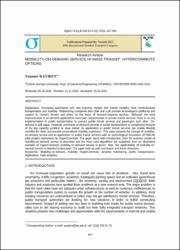Mobility-on-demand servıce in mass transit: hypercommute options
Özet
Digitization, increasing automation and new business models like shared mobility have revolutionized transportation and mobility. Ridesharing companies like Uber and Lyft provide technological platforms and support to connect drivers and riders on the basis of demand-response services. Although the most improvements in on-demand applications have been experimented in private transit services, there is no any implementation in public transportation to connect public transit services and passengers each other. On-demand is still vague. However, providing on-demand services in public transportation is complicated because of the big capacity problem in mass transit, its application in public transit services can enable flexible mobility for riders and provide personalized mobility experience. This paper presents the concept of mobilityon-demand service and its application in public transit services with an technological innovation of FM/LM pilot project represented by HyperCommute. The paper starts with introduction, then the business model of mobility-on-demand service is described and the most used algorithms are explained, then an illustrative example of HyperCommute mobility-on-demand service is given. Also, the applicability of mobility-ondemand service in Istanbul is discussed. The paper ends up with conclusion and future directions.

















